The Samsung Galaxy S7 and S7 edge Review: Part 2
by Joshua Ho on July 5, 2016 8:00 AM ESTSystem Performance Cont'd
Now that we've gone over the more general purpose system benchmarks we can focus on new benchmarks that emphasize GPU performance much more strongly. For the most part we haven't had huge issues here like we've had with good CPU and general performance benchmarks, but it's important for us to keep our benchmarks up to date in terms of workload balance and overall performance.
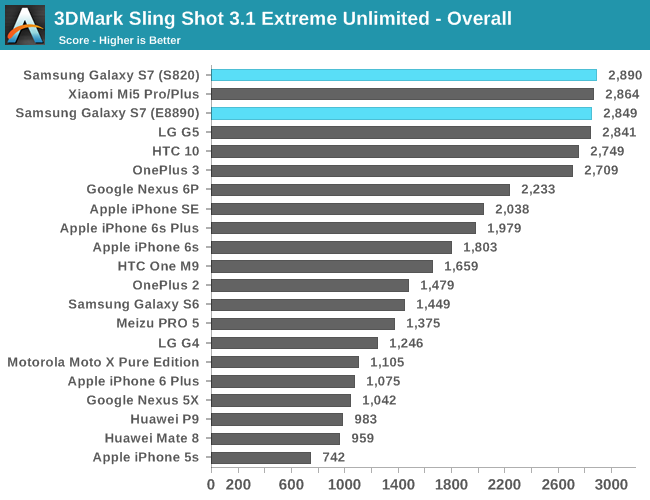
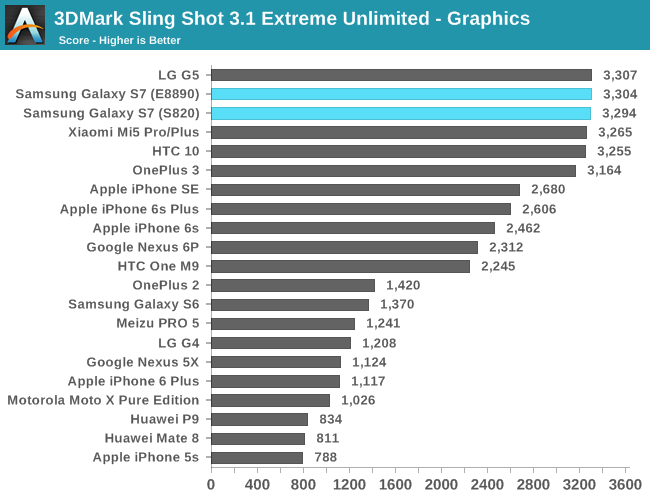
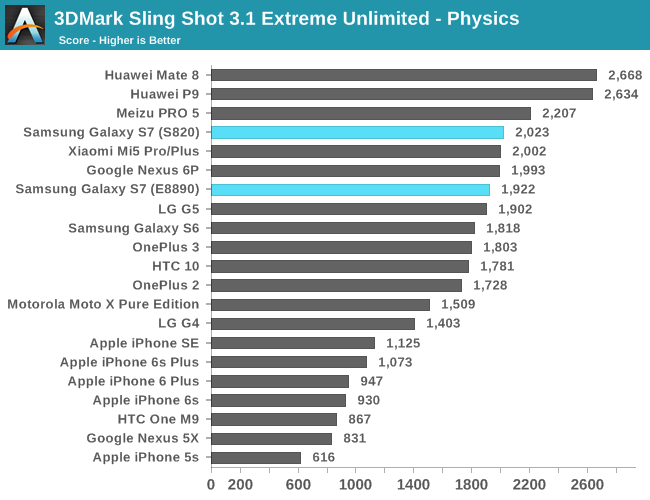
One of our first new benchmarks designed to better test the GPU is 3DMark's Sling Shot ES 3.1 test, which is designed to test a GPU's performance when the application is either using OpenGL ES 3.1 or Metal. As one can see, the Snapdragon 820 and Exynos 8890 have basically comparable GPU performance in this test and in the physics test as well. Once again we're seeing how core count and clock speed are basically the primary determinants of performance in the physics test when the device isn't strongly limited by thermals. I wouldn't draw any real conclusions from this as generally game CPU code can extract ILP unlike what we're seeing in this test.


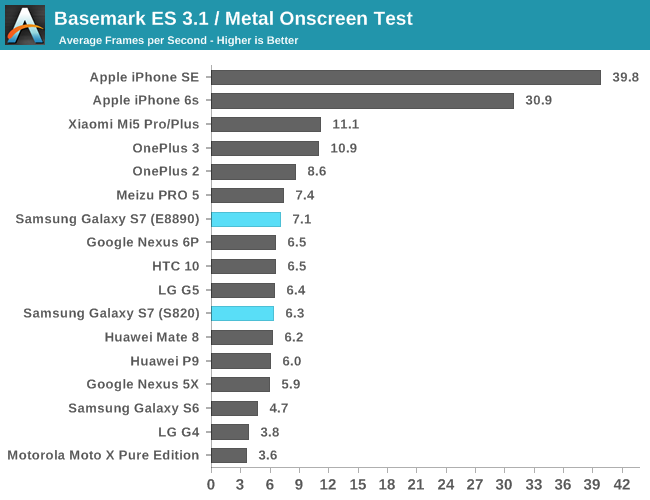
In this test we start to see that the Mali GPU in the Exynos 8890 and the PowerVR GPU in the A9 are providing a noticeable advantage over the Snapdragon 820's Adreno 530 to a noticeable extent.

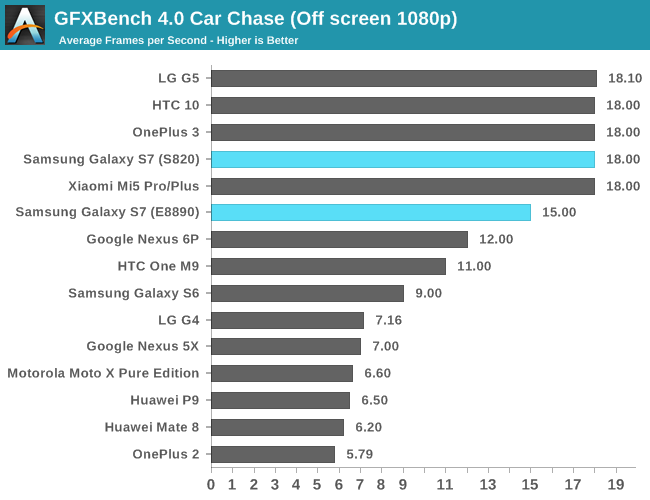
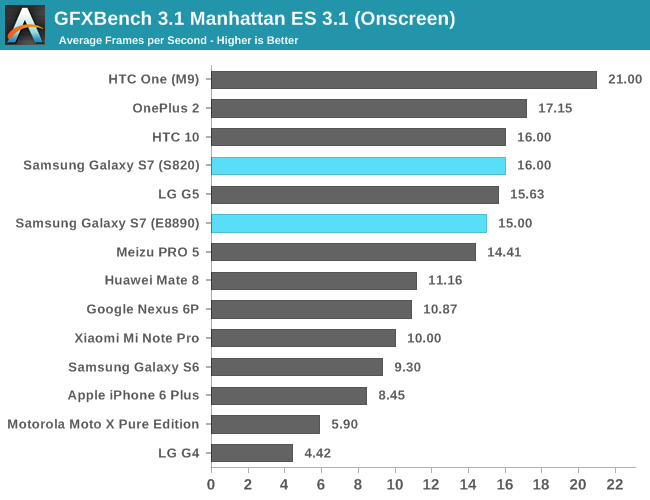
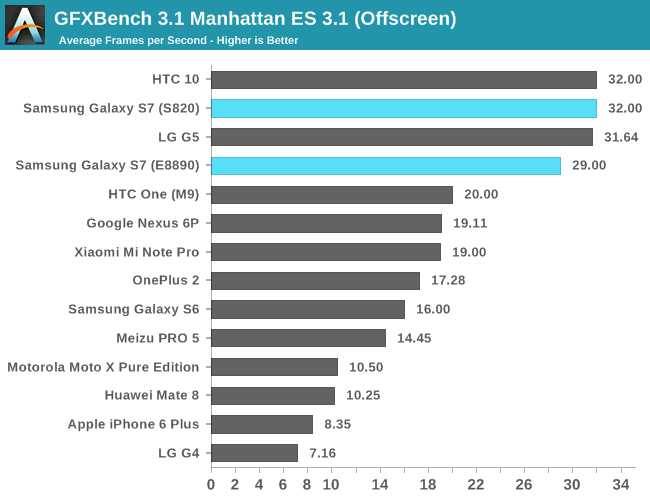
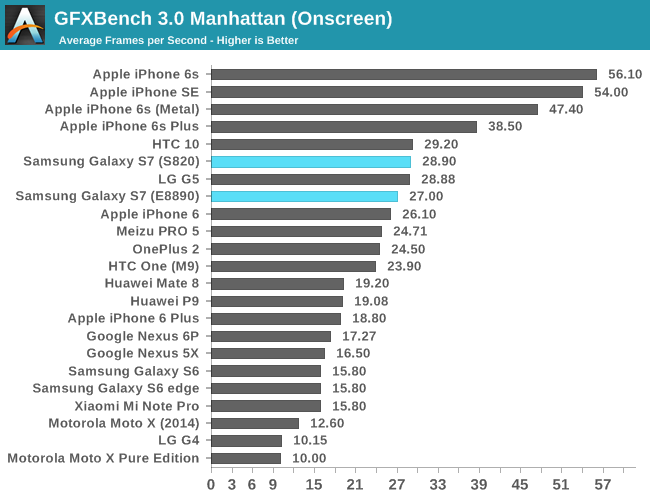
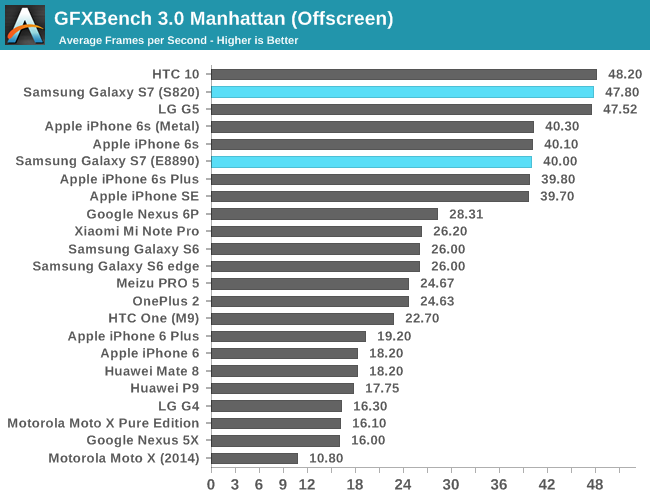
With GFXBench we can see that in Car Chase and Manhattan the Adreno 530 actually manages to pull away. However, because we have basically zero architecture disclosure on the Adreno 530 there's really no way for us to explain what's going on here and why. The reasons for the difference in performance could be related to drivers or architecture or architecture implementation and in the absence of information it's probably best to avoid making blind guesses. Regardless of these details, the Snapdragon 820's GPU should be more than enough for playing the latest games, but unless you use Samsung's automatic game optimizer system to set render resolution to 1080p it won't do as well as the iPhone 6s but given that most Android games target a much lower spec level it's likely that you won't have any problems given that the Adreno 530 is on the bleeding edge for Android SoCs.










266 Comments
View All Comments
The Garden Variety - Tuesday, July 5, 2016 - link
From now on, Anandtech should first conduct a comprehensive survey of people's anecdotal experiences with a given product, and compare those anecdotes against their completed (but unpublished) review. Any instance where the anecdotes disagree with the un-published findings, those un-published findings should immediately be removed, or changed to reflect agreement with the consensus of anecdotes. Any refusal to do so, or immediately acknowledge the veracity of those anecdotes is a sign of bias, and the likelihood that great sums of money are changing hands behind the scenes becomes self-evident.There's no place for technology reviews that do not reflect consensus. None. To believe otherwise means you are part of the conspiracy and your opinions on all subjects are invalid.
MonkeyPaw - Tuesday, July 5, 2016 - link
I see what you're saying, but sometimes you have to question testing methodology. In my case, the LG G4 scores lower battery on wifi versus LTE. That goes against my personal experience, but it also goes against the long-standing expected results. By nature, wifi shoukd be better, as the phone is closer to source and disables mobile data to boot. Pointing this out should hopefully provide insight to AT.whiteiphoneproblems - Tuesday, July 5, 2016 - link
Haha -- um, I'm almost certain TGV is being sarcastic (as in their other great comments here).name99 - Tuesday, July 5, 2016 - link
Where's the usual comment complaining about one month and still no GTX 1080 review?Someone is slipping up!!!
Michael Bay - Wednesday, July 6, 2016 - link
I don`t see you shilling for crapple either!vyis - Tuesday, July 5, 2016 - link
I feel that this new review is a degradation compare to previous method.First of all, why do a in-lab like battery life measurement while disabling all the background services? There's a fare share of background service that should be left running to show differences in manufacturer control of background service (and samsung is particular bad at this)
On the GPU side, it's not an accurate statement for say SD820 won't do as well in game as A9. It depends on Game API and GPU design bias on type of raw processing core. On android, game developer may not code to harness the full potential of SD820 processing power. Apple did have upper hand as they straight down hardware to software control.
There's a mistake at camera section. "There is nothing out there that can realistically match the dual pixel AF system in the Galaxy S7, especially once you get into low light scenarios where traditional PDAF systems are overwhelmed by noise" Instead of PDAF, it should be contrast detection AutoFocus that struggle in low light.
For daylight still, samsung do have more sharping processing, however, 6s plus is not light on post-processing. In good lighting condition, 6s plus process away too much details. Without raw file i can't be sure type of processing being done. More over, s7 lens element is of sharper focus compare to 6s plus.
For low light still, i'm interested in all the 6s s7 comparison mention all over the article, just click into original file and see for yourself. For s6 and s7 comparison, it's hard to say without raw file. A different direction of post processing is being used.
Regardless, i can't agree that samsung have gone the direction of stronger noise reduction and sharpening. I can obviously see a much stronger noise reduction used on s6 low light still.
Video wise no comment. Sony digital image stabilization is best implementation on smartphone. Those tiny OIS on smartphone just making viewer sea sick.
Battery life, i do agree s7 is just ok. Sammy software have a problem in control background activity.
Impulses - Thursday, July 7, 2016 - link
Dunno whether you can really make any generalisation regarding PDAF vs CDAF in low light... If you go look at high end cameras, the best DSLR out there tend to AF pretty great in low light but not necessarily across the whole frame and not all high end DSLR are equally adept at it.Then you look at mirrorless bodies which traditionally rely on CDAF more heavily and there's a lot of them (even with smaller sensors like Panasic/Olympus) that can absolutely nail low light AF regardless.
Most of the mirrorless bodies are going with a hybrid approach anyway (largely for C-AF purposes, which falls well beyond what any phone is capable of), so yeah, I dunno... Seems like a pointless generalisation.
On a technical level Samsung's dual pixel AF seems pretty interesting, it's odd that it never saw the light of day in their larger sensors and NX system before they killed it off.
joex4444 - Tuesday, July 5, 2016 - link
Huawei, Xiaomi, and OnePlus are priced the way they are because they have next to no brand recognition. If they can start to prove a track record of quality phones that have demand, I would expect them to start selling for $600-$800 not $400.UtilityMax - Tuesday, July 5, 2016 - link
If Oneplus, like a decade later, finally earns a widespread brand recognition so it can charge some premium prices for its products, then some other startup manufacturer will take their place. In fact, sooner or later we're going to see a collapse of the prices of the big brand smartphones. We have already reached a "peak iPhone" in the sense that a LOT of people who are owning a three year old flagship smartphone will no longer be compelled to shell out 600-800 bucks for this years latest model. 200-300USD is already new normal for the mid-range smartphones. I just saw a brand new Moto G4 test phone at Best Buy, and that's how they're priced already.fanofanand - Wednesday, July 6, 2016 - link
This right here. Commoditization is taking place like in the PC space, and while there may be a few remaining "high-end" phones out there, the VAST majority of sales will come in the sub $400 space. With subsidies disappearing, fewer and fewer people will shell out $700-1000 for a new phone every year, or even every other year. Just taking a look at the mid-range phones in the $200-300 space, as you mentioned, yields a huge number of competent phones that will meet the majority of users needs. Apple is going to need a new trick to maintain it's profitability, which is probably why they are flinging things at the wall in desperation, i.e. the watch, the Apple Car, etc.